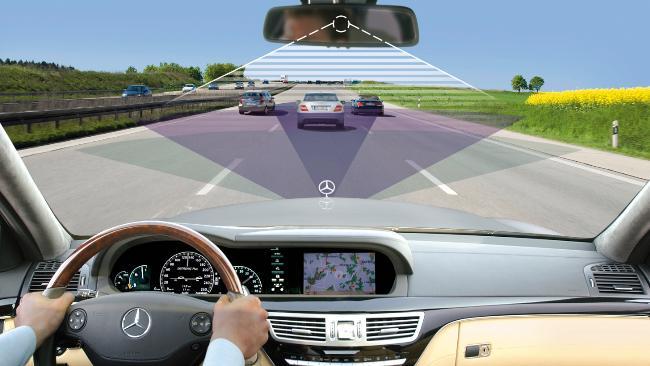Safety comes to its sensors
THE latest technology can read the road and stop a car automatically to prevent a collision.

IN glossy brochures, airbags are puffy cushions that turn the inside of a car into a bouncy castle. Those images make a car look safe enough to drive off a cliff.
In reality, airbags work so quickly, they have inflated and deflated before you know it. All that's left is a limp envelope of fabric. It's not uncommon for people to think they failed to go off at all.
There are many thousands who can be grateful they do. Ill-founded early scares about airbags have been replaced by decades of data. In the US they have saved 28,000 lives since they first appeared 30 years ago, according to the National Highway Traffic Safety Administration.
That anniversary was marked last month by Mercedes, which debuted the technology in a 1980 S-Class, its flagship sedan.
In combination with the seatbelt, which first appeared in a Volvo 50 years ago last year, the two safety innovations have been remarkably effective at cutting road tolls. We are driving more, and many more of us are driving, but prospects in an accident have never been better. The NHTSA calculates seatbelts and airbags together lower the chances of fatal injury by more than 60 per cent.
Which is one of the main reasons why most developed countries have seen road fatalities, measured as the number of people killed each year per 100,000 of the population, steadily decline since peaking in the 1970s.
However, the actual number of accidents hasn't gone down and a car is still risky compared with alternatives, such as a plane or train.
Mercedes head of safety Ulrich Mellinghoff says there's much room for improvement. "We think we'll be able to reach the safety level of planes in a few years," he says. In Germany, this would involve cutting the death rate by three-quarters.
Finding new ways to lower the road toll dramatically is getting more difficult. There's a limit to the airbags you can fit in a car but engineers are still finding new places. The latest are pelvis bags in the front seats, which protect better in a side crash.
On the way are airbags between the two front occupants to stop them smashing heads together, and bags fitted into seatbelts to help protect rear passengers. This is more technically challenging because a seatbelt is subject to a lot of wear and tear. But it will help compensate for the fact that it's too difficult to make effective frontal airbags for the rear.
As airbags reach the limit inside, deploying them outside opens up other possibilities. Mercedes is experimenting with a bag that deploys under the engine bay when collision is inevitable, to help slow the vehicle. Even for a split second, the extra braking force from its friction coating is worthwhile. The effect is like an additional crumple zone, with deceleration at 50km/h equivalent to another 18cm of car.
Another system in development would bolster protection where it's thinnest, in a side-impact. Instead of being solid, the beams in the doors consist of two pieces of metal that can be inflated just before impact to more effectively resist intrusion.
These ideas and many more are being explored in a Mercedes experimental safety vehicle, a showpiece S-Class fitted with gadgets still in development. It continues a tradition at the brand that dates back to the first crash tests conducted in 1959.
Although computer simulation has relieved some of the burden of smashing actual vehicles, like most carmakers, Mercedes's internal test regime is more extensive than regulations require, or independent test bodies could afford. It takes 40 individual crashes to satisfy the global market, with US rules the strictest. Mercedes conducts 500 annually.
Ten years after its crash test regime began, Mercedes pioneered field research into the causes of accidents. It was the first to send its specialists out on to the roads to study how crashes happen. It now has 40 years of data that can plot the impact of technology as it's introduced.
Seatbelts and airbags have one thing in common: they protect you when a crash is happening. In recent years, attention has turned to preventing accidents in the first place.
"Traffic accidents occur because people make mistakes; it's only very seldom that other factors play a significant part," Mellinghoff says.
Carmakers began to combine the power of computers with sensors scattered across a car to intervene before a crash. A car's computer can react more quickly than a driver in response to a brake lock-up, say, and then act more reliably. In ABS it takes control of the brakes, modulating them for maximum stopping power.
Electronic stability control, which is designed to stop a skid, is the cornerstone of these systems and on a par with the seatbelt and airbag in significance. Mercedes has offered ESC since 1995 and most cars on sale now have a version of it. ESC does something the driver cannot do: it brakes individual wheels selectively to pull a car back into line. Modern systems also ease off the throttle and apply counter-steering.
The next development was brake assist, which registers panic braking and applies maximum stopping power. Many drivers lift, even when they have braked hard initially, so don't get the best from their brakes.
Sensors can also subtly assess occupants. When passengers buckle up, the amount of belt fed out is an indirect way of measuring the passenger. The system tailors airbag deployment to suit. Mercedes has a drowsiness alert system that monitors the steering style of a driver and notices the minute over-corrections characteristic of tiredness.
Increasingly, sensors are used to size up the environment around the car. A fully optioned luxury vehicle has an astonishing array of radar and cameras that can inform, warn and, if the driver doesn't act, intervene.
Blind-spot warning systems and lane departure alarms, which rely on cameras, are becoming increasingly common. Combined with radar scanners these systems can tell whether the objects being picked up are cars or pedestrians, and even calculate their trajectory, flashing a warning if impact is imminent. Fit infra-red cameras and night vision becomes possible.
The next step is to use this information to apply the brakes if the driver doesn't react. Initially, the goal was to mitigate an impact but systems now coming to market apply full stopping force and in some circumstances can avoid a collision completely. At low speeds, this can mean the difference between hitting a pedestrian or not. Volvo will be first with this technology, although the Germans are not far behind.
There are indirect safety benefits from cameras and radar, too, especially combined with other technologies such as LED lights. These consist of multiple elements that can be individually controlled, allowing them to follow the path of the road and automatically adjust to the weather, lighting conditions and oncoming traffic without compromising overall vision. It's a huge advance from the simple choice between dipped and main beam.
According to Mellinghoff, the next big step will be car-to-car communication, although to work it needs to be fitted to about 25 per cent of cars. However, the effect would be to vastly extend the range of the sensors. Instead of waiting to encounter black ice or fog, say, the unseen car in front could send an ad hoc warning. With German carmakers already conducting trials of these systems, the next landmark safety step may not be far away.


